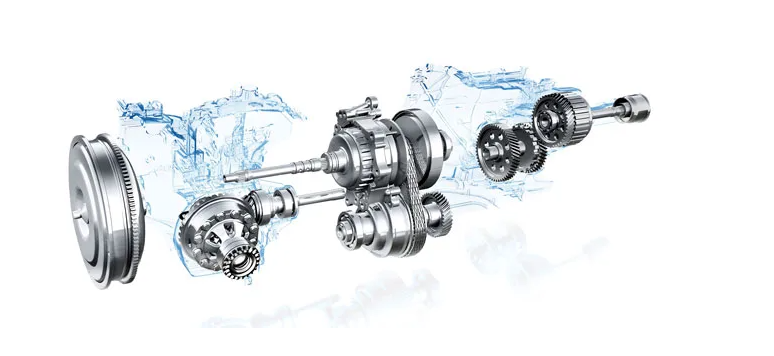

The CVT Gearbox (Continuously Variable Transmission)
A Continuously Variable Transmission (CVT) is a type of gearbox that operates differently from a traditional automatic transmission. While a traditional automatic uses fixed gear ratios to change gears, a CVT uses a system of pulleys and a belt to offer an infinite range of gear ratios. This means the engine can always operate at its most efficient RPM for the given driving conditions, resulting in smoother acceleration, better fuel economy, and potentially lower emissions.
Here’s an analogy to help understand the difference: Imagine riding a bike with gears. With a traditional automatic transmission, it’s like having a limited number of gears, and you have to shift between them as you change speed. With a CVT, it’s like having an infinite number of gears, so you can smoothly adjust the pedaling to maintain the perfect balance of speed and effort.

History:
While the exact first commercial car with a CVT is subject to some debate, the strong contenders for the title are Daf 600 Variomatic (1958) and the Honda Civic CVT (1981). Both played pivotal roles in pioneering and popularizing CVT technology in the commercial car market. So, whether you give the crown to the Dutch ingenuity of the Daf or the global impact of Honda’s innovation, remember that both companies hold significant historical weight in bringing the smooth and fuel-efficient world of CVTs to everyday drivers.
Advantages
Effortless Acceleration:
Imagine pressing the gas pedal and your car responding like an extension of your own foot. CVTs eliminate the power dips and jolts common in traditional automatics. Instead, you get a continuous surge of power, making uphill climbs feel effortless and highway merges whisper-smooth. It’s like riding a wave of torque, propelling you forward with exhilarating responsiveness.
Fuel Efficiency Champion:
The CVT’s continuous adjustment keeps your engine purring in its sweet spot, where it sips fuel like a hummingbird on nectar. This translates to significant fuel savings compared to traditional automatics, especially in city driving with its stop-and-go nature. Think of it as extra pocket money earned with every smooth kilometer you roll.
Whisper-Quiet Comfort:
No more engine roars at every acceleration! CVTs keep the engine revs at a minimum, resulting in a noticeably quieter cabin. Imagine cruising down the highway with just the gentle hum of the tires and the wind, transforming your car into a sanctuary of serenity. Whether you’re enjoying a family road trip or savoring a solo commute, the quietude of a CVT adds a touch of luxury to every journey.
Conversion:
Converting a traditional gearbox to a CVT is technically possible, but it’s a complex and expensive undertaking. It’s like trying to transplant an entirely different organ into your car’s circulatory system. Ultimately, converting your car’s gearbox to a CVT is a niche option best suited for passionate enthusiasts with deep pockets and the technical know-how to tackle such a complex project. For most drivers, selling and upgrading to a car with a factory-equipped CVT might be the more practical and cost-effective choice.
Drawbacks
Lack of Engagement:
CVTs often feel less engaging than traditional automatics due to the absence of distinct gear changes. You might miss the satisfying kick of downshifts or the responsive control of manuals. This can be particularly noticeable in performance-oriented cars where the CVT struggles to replicate the sporty feel of traditional transmissions.
Potential Repair Costs:
While generally reliable, CVT technology is still evolving. Some older models can be prone to overheating or belt issues, leading to expensive repairs. Additionally, specialists trained in servicing CVTs might be harder to find compared to mechanics working on traditional transmissions.
The future of transmissions?
While not without its critics, the CVT gearbox is undeniably shaking things up in the automotive world. From silky acceleration to impressive fuel efficiency, it’s easy to see why CVTs are gaining traction. But the story isn’t black and white. The lack of engagement for driving enthusiasts and potential repair costs remain considerations. Ultimately, the CVT’s true potential lies in finding the perfect balance between smooth efficiency and driver satisfaction. As technology evolves and manufacturers refine their offerings, the CVT might just become the champion of future commutes, offering a comfortable and sustainable ride for the eco-conscious driver who prioritizes practicality over adrenaline. So, buckle up, keep an eye on the horizon, and see where the CVT revolution takes us next.
Add a comment Cancel reply
Categories
- Car Gadgets (17)
- Car News (33)
- Car Reviews (43)
- Car Wars (7)
- Mechanicals (32)
- Uncategorized (2)
Recent Posts
About us

Popular Tags
Related posts


Essential Car Repair Skills Every Driver Should Know

All About Wheel Balancing








